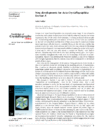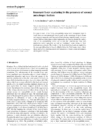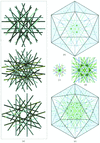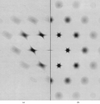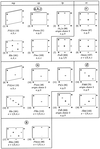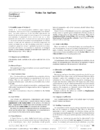issue contents
January 2000 issue

Cover illustration: Unit cell of a self-intersecting minimal surface with symmetry I432. The surface subdivides R3 into two congruent three-periodic mutually interpenetrating labyrinths with symmetry P4232. Lines of self-intersection are marked in red. See Koch [Acta Cryst. (2000), A56, 15-23].
editorial
Free 

research papers
The general form of the resonant part of the X-ray susceptibility tensor near absorption edges is found when there are several anisotropic factors in a crystal. The simultaneous existence of anisotropy of local atomic environment, magnetic ordering and orbital ordering is considered in detail.
A novel approach to diffraction analysis of decorated quasicrystals is discussed. An average unit cell has been constructed for a decorated Fibonacci chain and used for analysis of its diffraction pattern.
Minimal surfaces with straight self-intersections may subdivide R3 into two, four or eight three-periodic labyrinths. The properties of such surfaces (three orientable and 44 non-orientable ones) are described.
The atoms in crystals partitioning scheme of the electron density has been implemented in the program VALRAY and some examples of integrated atomic properties are given using two recent charge-density studies.
The structures of a new modification of Ti2Se and several related metal-rich compounds were solved from selected-area electron diffraction data using quasi-automatic direct methods.
It is well known that there exist five arithmetic (Bravais) types of 1-nets (two-dimensional simple lattices). We show that there exist also five distinct arithmetic types of monoatomic 2-nets (two-dimensional lattices with two identical points on their unit cell).
Building rules are determined for icosahedral quasiperiodic packings of fibres of circular cross section whose axes are parallel to either threefold icosahedral axes or both fivefold and threefold icosahedral axes.
Electron diffraction intensities from poly(1-butene) are the basis for least-squares structure refinement. With soft constraints placed on bond lengths, an improved structural model can be obtained, despite multiple-scattering perturbations.
The distribution and scattering interference functions are calculated for two-dimensional hexagonal paracrystals. This modelling respects the hexagonal symmetry, which is not the case for general modelling.
Mathematical tools are developed for the decomposition of a distribution in the unit cell into a weighted sum of shifted copies of the same function chosen in advance.
Short-range ordering in a ternary alloy is discussed according to the ordered microdomain model. The negative X-ray partial intensity can be explained by a mixing occupation of different atoms on the sublattice of the ordered lattice.
An explanation and proof are given of the different kinds of cost-minimizing planar double crystals that can occur, assuming an interface that carries a fraction of the energy (per unit length) of the faces.
Free 

An ambiguity in the definition of `symmetry element' is removed by redefining the `geometric element'. A revised diagram of glide-plane aspects is presented that contains three more than the 15 illustrated previously.
international union of crystallography
Free 



 journal menu
journal menu









